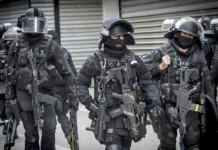The Marine Corps is shifting focus from the Cold War and GWOT era systems and looking at near peer warfare for 2020 and beyond. The tanker battalions, three of them, are being removed from the force. It’s a bittersweet shift for those within the Marine Corps who are those armored operators but it is in line with the two goals the Commandant has outlined.
The first is, sadly, budget cuts. Less expensive legacy equipment means more for new equipment and the Marine Corps is scaling back across the fleet. No more tanks, bridging, or police battalions. Fewer F35’s and infantry battalions too. All of these will save money.
The second and more poignant reason is mission refocus. The Marine Corps in my time (06-14) was operated like a smaller US Army in many respects. This was because of the mission in the Middle East. The type of combat and the mission profiles between AO’s given to the Army and AO’s given to the Marine Corps were generally.. the same. Conditions within the AO’s might vary widely and the OpFor, civilian situation, partner forces, and any number of factors could result in very different missions on the ground level. However the 30,000 foot view of the situation had the Army and Marines doing essentially the same thing wherever we needed troops on the ground.
That was the need. That was the mission of the time and Marines carried it out. But it is not the mission of the Corps overall. That mission is to be a flexible naval infantry force. To control islands and shorelines, assist the navy in boarding ships, raiding, directing shore fires, and in general be able to very quickly be dropped into somewhere by naval assets and cause absolute havoc on the ground.
That mission requires a fast moving, lightweight, semi-decentralized ground force that can be placed and removed quickly. Tanks don’t fit that equation, especially when we look at how light and effective anti-tank weaponry is becoming. Tanks are becoming more targets and less hard kill infantry support assets. Tanks, especially main battle tanks like the M1A1 and A2, are heavy and need proper terrain. The mobility limitations, increased ease of disability or destruction, and increase in prevalence of lighter anti-armor and anti-vehicle weapon systems make the role of the main battle tank an unnecessary one for the Corps’ mission.
Long story short, when you have a bunch of things that aren’t tanks that can kill tanks you probably don’t need tanks. You need ways to quickly move your troops to and from their AOs and support them with fire. The longer range precision rocket artillery, troop portable systems, air support, etc. are available. The Marines clashing with other ‘infantry’ forces, both conventional and unconventional, is their forte. It’s also what the Navy most needs them for, go dislodge infantry that are on islands or shorelines that could use weapon systems to threaten the ships.
Think of it this way. The Marine Corps is a flexible larger scale special mission force, it has a role more wide spread and covering more than something like a SEAL team but is not the national scale that the Army is designed for. A special forces unit will be for small scale surgical mission profiles. The Marines will be for rapid, larger, short to moderate duration mission profiles in direct support of Navy combat operations and to establish routes for Army units depending on mission scale. The Army, as a whole, is for national level long term operations where we’re changing someone’s government, sweeping through the country like a snow plow, and going sit on them awhile.
Combined Arms doctrine and all those fun buzzwords. The Commandant is shifting the Marine Corps into that mission profile. Light to moderate presence, short to moderate duration, ship to shore fire supported and/or high mobility precision ground based fire supported, with the ability to leave just a quickly and repeat the mission on the next island or shoreline they need to.
So, while it is a sad day to see the Marines lose a legacy MOS steeped in lore and history, a force must continue to evolve to today’s missions. The tank might not be gone forever, technology and mission might bring armored battalions back the Marine Corps’ mission profiles. But for the moment this seems like a wise move. The vehicles that the Corps brings in to support their mission instead of tanks will be key to making this a success.



